Papers by Mirella van Den Doel
Cardiovasc Res, 1998
Skip Navigation. ...

J Mater Sci Mater Med, 2002
The osteoinductive potential, or bone induction potency, of two calcium phosphate ceramics was ev... more The osteoinductive potential, or bone induction potency, of two calcium phosphate ceramics was evaluated after intramuscular implantation in goats. The ceramics were comprised of hydroxyapatite (HA) and biphasic calcium phosphate (BCP), the later of which contained a 85/15 mixture of hydroxyapatite and tricalcium phosphate (TCP). Both ceramics had a similar macroporosity of around 55% and a pore distribution between 100 and 800 mm. Besides the difference in chemistry, BCP was also microporous and hence had a different surface microstructure. After implantation in the back muscles of four goats for 12 weeks, all 8 BCP samples (7 6 7 6 7 mm 3 ) showed the presence of bone formation in the macropores (1 + 1%), while no bone was found in any of the HA samples. The used BCP can therefore be characterized as an osteoinductive material. Having the ability to induce bone formation in soft tissues, the BCP presented herein may be a useful biomaterial for bone repair when combined with cultured osteogenic cells, growth factors or both.
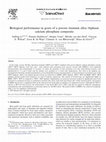
Biomaterials, Oct 31, 2007
In this study, porous 3D fiber deposition titanium (3DFT) and 3DFT combined with porous biphasic ... more In this study, porous 3D fiber deposition titanium (3DFT) and 3DFT combined with porous biphasic calcium phosphate ceramic (3DFT+BCP) implants, both bare and 1 week cultured with autologous bone marrow stromal cells (BMSCs), were implanted intramuscularly and orthotopically in 10 goats. To assess the dynamics of bone formation over time, fluorochrome markers were administered at 3, 6 and 9 weeks and the animals were sacrificed at 12 weeks after implantation. New bone in the implants was investigated by histology and histomorphometry of non-decalcified sections. Intramuscularly, no bone formation was found in any of the 3DFT implants, while a very limited amount of bone was observed in 2 BMSC 3DFT implants. 3DFT+BCP and BMSC 3DFT+BCP implants showed ectopic bone formation, in 8 and 10 animals, respectively. The amount of formed bone was significantly higher in BMSC 3DFT+BCP as compared to 3DFT+BCP implants. Implantation on transverse processes resulted in significantly more bone formation in composite structure as compared to titanium alloy alone, both with and without cells. Unlike intramuscularly, the presence of BMSC did not have a significant effect on the amount of new bone either in metallic or in composite structure. Although the 3DFT is inferior to BCP for bone growth, the reinforcement of the brittle BCP with a 3DFT cage did not negatively influence osteogenesis, osteoinduction and osteoconduction as previously shown for the BCP alone. The positive effect of BMSCs was observed ectopically, while it was not significant orthotopically. r
Basic research in cardiology, 1997
ABSTRACT

Journal of materials science. Materials in medicine, 2002
The osteoinductive potential, or bone induction potency, of two calcium phosphate ceramics was ev... more The osteoinductive potential, or bone induction potency, of two calcium phosphate ceramics was evaluated after intramuscular implantation in goats. The ceramics were comprised of hydroxyapatite (HA) and biphasic calcium phosphate (BCP), the later of which contained a 85/15 mixture of hydroxyapatite and tricalcium phosphate (TCP). Both ceramics had a similar macroporosity of around 55% and a pore distribution between 100 and 800 microm. Besides the difference in chemistry, BCP was also microporous and hence had a different surface microstructure. After implantation in the back muscles of four goats for 12 weeks, all 8 BCP samples (7x7x7 mm(3)) showed the presence of bone formation in the macropores (1+/-1%), while no bone was found in any of the HA samples. The used BCP can therefore be characterized as an osteoinductive material. Having the ability to induce bone formation in soft tissues, the BCP presented herein may be a useful biomaterial for bone repair when combined with cultur...

Tissue Engineering Part C: Methods, 2014
Enzymatic isolation of chondrocytes from a cartilage biopsy is the first step to establish in vit... more Enzymatic isolation of chondrocytes from a cartilage biopsy is the first step to establish in vitro models of chondrogenesis or to generate cell-based grafts for cartilage repair. Such process is based on manually operated procedures and typically results in yields lower than 20% of the total available cells. In this study, we hypothesized that, as compared to conventionally used protocols, the enzymatic digestion of human articular cartilage in the presence of ascorbic acid 2-phosphate (AscA2P) or of sodium chloride (NaCl), in combination with the use of a perfusion bioreactor system, leads to a higher and more reproducible yield of cell populations with high proliferation and chondrogenic capacity. The addition of AscA2P within the enzymatic digestion medium did not significantly increase the cell yield, but resulted in a significant decrease of the intradonor variability in cell yield (-17.8%±10.7%, p=0.0247) and in a significant increase of the proliferation rate of the isolated chondrocytes (+19.0%±1.4%, p<0.05) with respect to the control group. The addition of NaCl during cartilage digestion did not modulate cell yield. When the cartilage digestion was further performed under direct perfusion flow, beneficial synergistic effects were achieved, with an overall increase of 34.7%±6.8% (p<0.001) in the cell yield and an average decrease of 57.8%±11.2% (p<0.01) in the coefficient of variation with respect to the control group. Importantly, by implementing this strategy it was possible to retrieve clonal subpopulations more efficiently capable of undergoing chondrogenesis, both in vitro and in vivo. Our findings bear relevance for the preparation of human chondrocytes for laboratory investigations, and in the perspective of efficient and streamlined manufacturing of cell/tissue grafts for articular cartilage repair.
Advances in Organ Biology, 1998
... The observationby Schulz and colleagues (1995) has been confirmed by a recent report of Ferra... more ... The observationby Schulz and colleagues (1995) has been confirmed by a recent report of Ferrari and colleagues (1996), who showed in isolated rabbit hearts that recovery of function (developed pressure) was less in a 28 PIETER D. VERDOUW, BEN CC CHO, and MIRELLA ...
Key Engineering Materials, 2006
Page 1. Performance of Osteoinductive Biphasic Calcium-Phosphate Ceramic in a Critical-sized Defe... more Page 1. Performance of Osteoinductive Biphasic Calcium-Phosphate Ceramic in a Critical-sized Defect in Goats P. Habibovic 1, a , M. van den Doel 1,b , CA van Blitterswijk 1,c and K. de Groot 1,d ... Key Engineering Materials Vols. ...
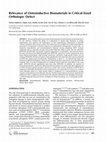
Journal of Orthopaedic Research, 2006
Several publications have shown the phenomenon of osteoinduction by biomaterials to be real. Howe... more Several publications have shown the phenomenon of osteoinduction by biomaterials to be real. However, whether the ability of a biomaterial to initiate bone formation in ectopic implantation sites improves the performance of such osteoinductive biomaterial in clinically relevant orthotopic sites remains unclear. No studies have been published in which osteoinductive potential of a biomaterial is directly related to its performance orthotopically. In this study, we compared osteoinductive and nonosteoinductive biphasic calcium-phosphate (BCP) ceramics ectopically and in a clinically relevant critical-sized orthotopic defect in goats. The two materials, BCP1150 and BCP1300, had similar chemical compositions, crystallinities, and macrostructures, but their microstructures differed significantly. BCP1150, sintered at a lower temperature, had a large amount of micropores, small average crystal size, and hence a high specific surface area. In contrast, BCP1300, with few micropores, had a significantly lower specific surface area as compared to BCP1150. Twelve-week intramuscular implantation in goats (n ¼ 10) showed that bone was induced in all BCP1150 implants, while no signs of bone formation were found in any of the BCP1300 implants. After 12 weeks of implantation in a bilateral critical-sized iliac wing defect in the same goats, BCP1150 showed significantly more bone than BCP1300. In addition, the analysis of fluorochrome markers, which were administered to the animals 4, 6, and 8 weeks after implantation to follow the bone growth dynamics, showed an earlier start of bone formation in BCP1150 as compared to BCP1300. Significantly better performance of an osteoinductive ceramic in a criticalsized orthotopic defect in a large animal model in comparison to a nonosteoinductive ceramic suggests osteoinduction to be clinically relevant. Further improvement of material osteoinductive properties is thus a significant step forward in the search for alternatives for autologous bone graft.
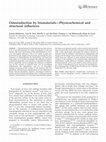
Journal of Biomedical Materials Research Part A, 2006
Osteoinduction by biomaterials has been shown to be a real phenomenon by many investigators in th... more Osteoinduction by biomaterials has been shown to be a real phenomenon by many investigators in the last decade. The exact mechanism of this phenomenon is, however, still largely unknown. This in vivo study in goats was performed to get insight into processes governing the phenomenon of osteoinduction by biomaterials and had four main goals: (i) to further investigate the influence of physicochemical properties and structure on biomaterial osteoinductive potential, (ii) to investigate the influence of implant size on the amount of induced bone, (iii) to investigate implantation site dependence, and (iv) to investigate changes occurring on the surface of the material after implantation. Intramuscular implantations of four different biphasic calcium phosphate ceramics, consisting of hydroxyapatite and -tricalcium phosphate and a carbonated apatite ceramic, indicated that, for a maximal osteoinductive poten-tial, there is an optimal specific surface area for each material type. It was further shown that a decrease of the implant size with a half significantly decreased the relative amount of induced bone. In addition, subcutaneous implantation did not give rise to ectopic bone formation in any of the animals, while bone was induced in most animals intramuscularly. Analysis of the surfaces of the materials after subcutaneous implantation inside diffusion chambers indicated that the increased specific surface area leads to more surface reactivity, which is hypothesized to be essential for osteoinductivity by biomaterials.

Circulation, 1996
Brief coronary artery occlusions (CAOs) protect both the artery's own perfusion territory... more Brief coronary artery occlusions (CAOs) protect both the artery's own perfusion territory ("myocardial preconditioning") and adjacent "virgin" myocardium. Whether ischemia in remote organs protects myocardium is unknown. We examined whether brief occlusion of the anterior mesenteric artery (MAO) or left renal artery (RAO) protects against myocardial infarction. Area at risk (AR) and infarcted area (IA) were determined in anesthetized rats after 180 minutes of reperfusion following a 60-minute CAO. At normothermia (body temperature, 36.5 degrees C to 37.5 degrees C), IA/AR was 68 +/- 2% (mean +/- SEM, n = 11) in control rats and 50 +/- 3% (n = 9, P < .001) in rats preconditioned by 15-minute CAO 10 minutes before 60-minute CAO. A 15-minute MAO was equally protective (IA/AR = 50 +/- 3%, n = 10, P < .001), whereas 15-minute RAO failed to limit IA/AR (72 +/- 5%, n = 8). Hypothermia (body temperature, 30 degrees C to 31 degrees C) did not affect IA/AR (67 +/- 3%, n = 11) in control animals but enhanced protection by 15-minute CAO (IA/AR = 22 +/- 3%, n = 8), whereas protection by 15-minute MAO (IA/AR = 44 +/- 5%, n = 11, P < .001) was minimally enhanced. Hypothermia unmasked protection by 15-minute RAO (IA/AR = 46 +/- 6%, n = 9, P < .01). Hexamethonium (20 mg/kg IV) did not alter protection by 15-minute CAO, but it abolished protection by 15-minute MAO. When MAO was sustained throughout the study, cardioprotection was absent. Brief ischemia in "remote" organs protects myocardium against infarction as effectively as myocardial preconditioning. The mechanism of protection by MAO differs from that of CAO, because ganglion blockade abolished protection by MAO but not by CAO. The neurogenic pathway is activated during reperfusion after 15-minute MAO, because sustained MAO failed to produce cardioprotection.
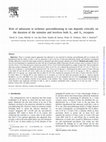
Cardiovascular Research, 2001
Objectives: There is currently general agreement that adenosine is not involved in ischemic preco... more Objectives: There is currently general agreement that adenosine is not involved in ischemic preconditioning (IP) in rat hearts. We hypothesized that the failure to show a role for adenosine is due to the use of brief preconditioning stimuli, and therefore investigated whether adenosine is involved when longer stimuli are employed and which receptor subtypes are involved. Methods and results: Infarct size (IS) was determined in anesthetized rats after 180 min of reperfusion (REP) following a 60-min coronary artery occlusion (CAO). IS was 6962% (n515) of the risk area in control rats and 4562% (n519; P,0.05) following IP by a single 15-min CAO. The non-selective adenosine receptor antagonist SPT, which itself had no effect on IS (7461%), blunted the protection by IP (IS55762%, P,0.05) in a dose of 235 mg / kg i.v., and abolished the protection (IS57061%) at 2325 mg / kg i.v. Following IP by three cycles of 3-min CAO and 3-min REP, IS was 2466% (P,0.05), which was not affected by SPT in doses of 2310 and 2325 mg / kg i.v. The A antagonist 3 MRS-1191 (3.3 mg / kg, i.p.), which itself did not affect IS (7062%), blunted the protection by IP with a 15-min CAO (IS55462%, P,0.05). When 235 mg / kg SPT (a dose selective for A -receptors, as it did not affect the protection by the A selective agonist 1 3 IB-MECA, 5163%) and MRS 1191 were combined the protection by IP was abolished (IS56762%). Conclusions: Involvement of adenosine in IP in rats depends critically on the duration of the stimulus. Thus, whereas adenosine was not involved when stimuli of 3-min duration were employed, activation of both A and A receptors contributed when a stimulus of 15 min was used. © 2001 1 3
Cardiovascular Research, 1998
Cardiovascular Research, 1998
To test the hypothesis that mild hypothermia potentiates the cardioprotection afforded by ischaem... more To test the hypothesis that mild hypothermia potentiates the cardioprotection afforded by ischaemic preconditioning so that Ž . Ž infarct size limitation can be obtained after coronary artery occlusion CAO durations which exceed the cardioprotective range ) 90
Biomaterials, 2007
3D fiber deposition is a technique that allows the development of metallic scaffolds with accurat... more 3D fiber deposition is a technique that allows the development of metallic scaffolds with accurately controlled pore size, porosity and interconnecting pore size, which in turn permits a more precise investigation of the effect of structural properties on the in vivo behavior of biomaterials.
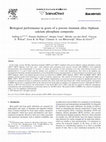
Biomaterials, 2007
In this study, porous 3D fiber deposition titanium (3DFT) and 3DFT combined with porous biphasic ... more In this study, porous 3D fiber deposition titanium (3DFT) and 3DFT combined with porous biphasic calcium phosphate ceramic (3DFT+BCP) implants, both bare and 1 week cultured with autologous bone marrow stromal cells (BMSCs), were implanted intramuscularly and orthotopically in 10 goats. To assess the dynamics of bone formation over time, fluorochrome markers were administered at 3, 6 and 9 weeks and the animals were sacrificed at 12 weeks after implantation. New bone in the implants was investigated by histology and histomorphometry of non-decalcified sections. Intramuscularly, no bone formation was found in any of the 3DFT implants, while a very limited amount of bone was observed in 2 BMSC 3DFT implants. 3DFT+BCP and BMSC 3DFT+BCP implants showed ectopic bone formation, in 8 and 10 animals, respectively. The amount of formed bone was significantly higher in BMSC 3DFT+BCP as compared to 3DFT+BCP implants. Implantation on transverse processes resulted in significantly more bone formation in composite structure as compared to titanium alloy alone, both with and without cells. Unlike intramuscularly, the presence of BMSC did not have a significant effect on the amount of new bone either in metallic or in composite structure. Although the 3DFT is inferior to BCP for bone growth, the reinforcement of the brittle BCP with a 3DFT cage did not negatively influence osteogenesis, osteoinduction and osteoconduction as previously shown for the BCP alone. The positive effect of BMSCs was observed ectopically, while it was not significant orthotopically. r
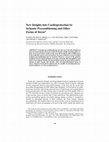
Annals of the New York Academy of Sciences, 1999
Ischemic preconditioning has not only received wide attention in heart research, but has also bee... more Ischemic preconditioning has not only received wide attention in heart research, but has also been a topic of extensive studies involving other organs. In several of these studies, it has been shown that in spite of differences in the endpoints used to assess protection, the same mediators as in myocardial ischemic preconditioning may be involved. However, several of the putative mediators do not require ischemia to become activated. This has guided us and others to investigate whether the myocardium can also be protected by brief ischemia in other organs and whether other non-pharmacological forms of stress, which do not produce ischemia but are capable of activating these potential mediators, are also cardioprotective. a This study has been supported by grants NHS 95.103 and D96.024 of the Netherlands Heart Foundation. Dr. Duncker's research has been made possible by a Research Fellowship of the Royal Netherlands Academy of Arts and Sciences.
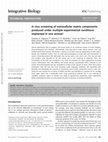
Integrative Biology, 2013
Animal experiments help to progress and ensure safety of an increasing number of novel therapies,... more Animal experiments help to progress and ensure safety of an increasing number of novel therapies, drug development and chemicals. Unfortunately, these also lead to major ethical concerns, costs and limited experimental capacity. We foresee a coercion of all these issues by implantation of well systems directly into vertebrate animals. Here, we used rapid prototyping to create wells with biomaterials to create a three-dimensional (3D) well-system that can be used in vitro and in vivo. First, the well sizes and numbers were adjusted for 3D cell culture and in vitro screening of molecules. Then, the functionality of the wells was evaluated in vivo under 36 conditions for tissue regeneration involving human mesenchymal stem cells (hMSCs) and bovine primary chondrocytes (bPCs) screened in one animal. Each biocompatible well was controlled to contain ml-size volumes of tissue, which led to tissue penetration from the host and tissue formation under implanted conditions. We quantified both physically and biologically the amounts of extracellular matrix (ECM) components found in each well.





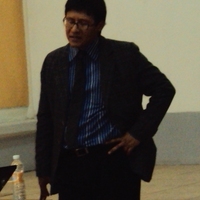
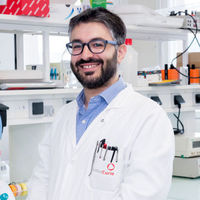

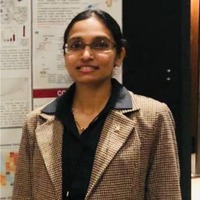

Uploads
Papers by Mirella van Den Doel